Most people would probably starve to death if they were left to their own devices in the wild. Yet, food is abundant all around us.
I’m not just talking about eating insects and dandelions. One of the best foods to forage is acorns.
Yes, you can eat acorns, but you must know how to prepare them first.
So Can You Eat Acorns?
In short, not only are acorns edible, but they are an important part of our nutritional history. (1, 2, 3)
We humans have been eating acorns for a long time. The practice even has its own name — “balanophagy” — and dates back thousands of years.
Paleolithic people regularly ate acorns as part of their diet. However, as agriculture developed, the practice of eating acorns declined. Still, archaeologists have discovered evidence of modern people eating acorns.
Acorns were popular with the Arcadians of Greece. Bushels of acorns were found on the “Sunken Village” site in what is now Oregon. According to one source, acorns provided about 20% of the rural diet in Spain and Italy up until the 19th century!
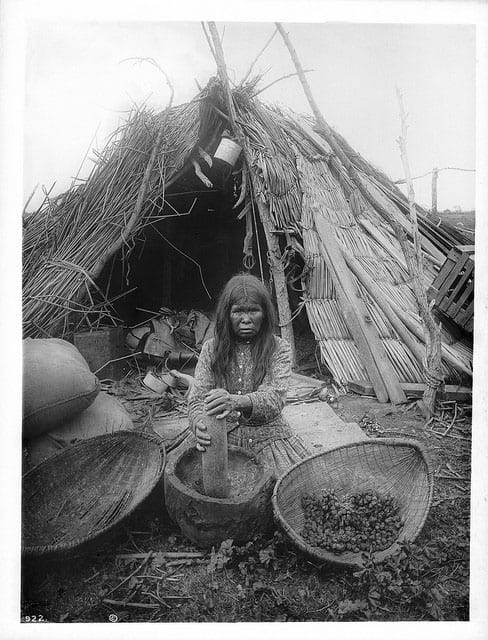
Balanophagy Trivia
- Acorns were used as a substitute for coffee during the Civil War.
- In 1945, Japan organized schoolchildren to harvest acorns as a substitute for rice and wheat.
- Today, acorns are most commonly used as hog feed.
Acorn Nutrition
The nutrition of acorns varies a lot depending on the oak type, the acorn’s age, the soil content, and how you prepare them.
Approximate values per 100g from the USDA are;
- Fat: 24g
- Protein: 6g
- Carbohydrates: 41g
- Water: 28g
- Vitamins: 1g
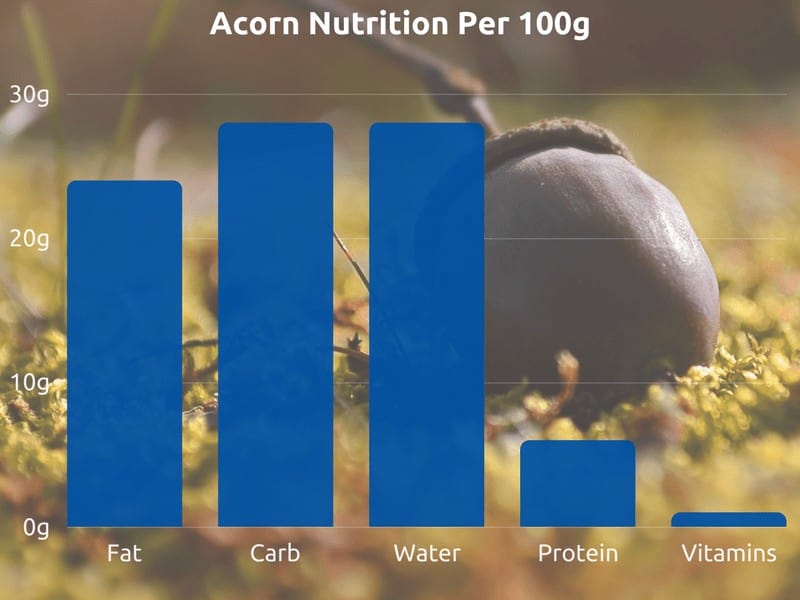
What Do They Taste Like?
Acorns don’t have much flavor to them, which makes them great for baking. I would describe the taste as a bland chestnut.
Step 1: Harvesting Acorns
So, you want to try eating acorns? The first step is the easiest. You need to harvest a bunch of acorns.
The great thing is that oak trees produce tons of acorns. In 1-2 weeks, you could gather enough acorns to feed yourself for 2 years! (6)
There are hundreds of types of oak trees, all of which produce edible acorns. All these oaks can be broken down into two main types: Red Oaks and White Oaks.
Red Oaks
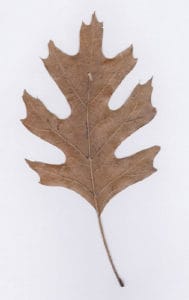
Red oak acorns generally have fewer tannins and take less time to leach (more on that later). You can identify the red oaks by their leaves with pointy tips.
White Oaks
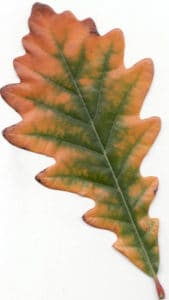
White oak acorns take longer to leach. These oaks have rounded leaves.
When to Gather Acorns
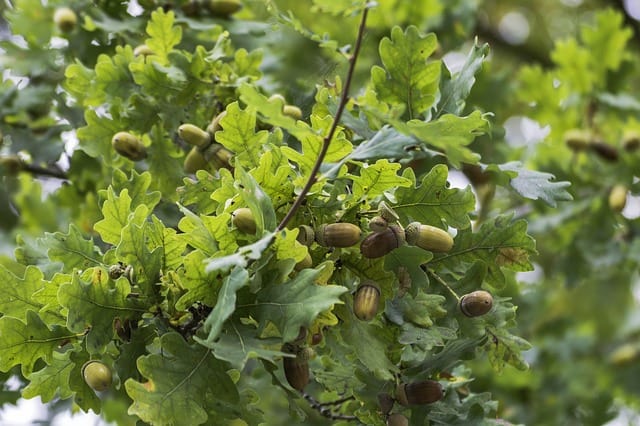
Acorns should be gathered when they ripen, usually around September or October. You can still gather acorns as late as December, but most of these will already be gotten by insects, squirrels, birds, or other animals that eat acorns.
Can You Eat Green Acorns?
NO, Nou cannot eat green acorns. However, you can gather and put green acorns in a dry place. Eventually, they will ripen and turn brown.
Methods of Gathering
- Pick acorns from the ground: This is the easiest method. However, many of the acorns will have already been invaded by grubs or fungi.
- Knock acorns off the tree: This is more labor-intensive, but fewer acorns will be damaged. Put a large tarp below the oak tree. Then, use a big stick to start knocking acorns off branches.
- Cutting off acorns: You can climb the oak tree and cut the tips of branches to get the clusters of acorns. It takes a lot of work, so you probably won’t use this method. (7)
Separating Good Acorns from the Bad Ones
Acorns make up a considerable part of the diet of wild animals. Especially if you are gathering acorns from the ground, a large portion will likely be invaded by grubs, fungus, or rot.
Get Rid of Any Acorns that:
- Have holes in them (a sign that insects such as the acorn weevil have laid their eggs inside)
- Are missing their caps
- Float (good acorns will sink)
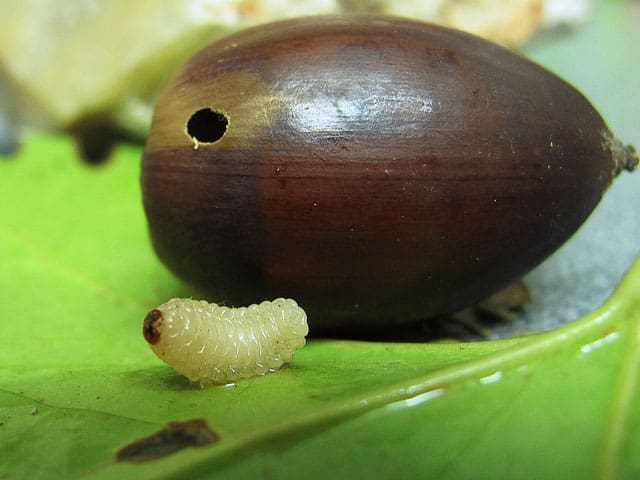
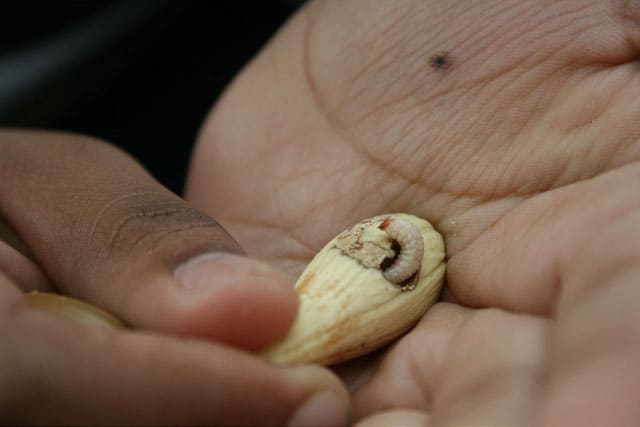
Step 2: Drying the Acorns
You don’t have to dry acorns before eating them. However, the shells will come off a lot easier. A “skin” also covers the meaty part of the acorn. Drying the acorns will cause this skin to flake off.
If you choose to dry your acorns, they can easily last for up to two years before processing and eating. Just make sure that they are in a dry area.
To dry your acorns:
- Lay out in the sun for several weeks
- Put in a food dehydrator – Food Dehydrator Reviews
- Roast in the oven at a low heat
Step 3: Shelling the Acorns
Shelling the acorn is a bit tedious, but it can also be fun. Just hit the acorn with a rock or a hammer. You want to crack the shell but don’t want to smash the acorn. Or use a nut nutcracker. The meat inside the acorn can vary in color from tan to dark brown. It is okay for the acorn to have spots.
While you shell, get rid of any bad acorns. If it has larvae or looks moldy, give it back to nature.
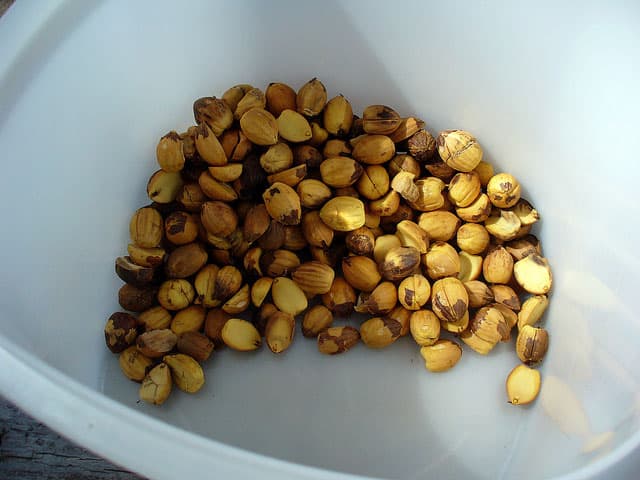
Step 4 “Winnowing” The Acorn Skins
Acorn meat will have papery skin. You don’t necessarily have to remove this skin, but it will make your acorns much tastier and give the flour a better texture.
After you’ve shelled all your acorns, put them into a big basket and rub them with your hands. This will cause the skin to flake off. Then, put the basket in a windy area (or in front of a fan) so the skins will blow off.
Step 5: Grinding the Acorns
You can skip this step if you want to munch on whole acorn nuts. However, leaching the tannins goes much faster when you ground the acorns into smaller bits.
Traditionally, acorns would be ground using a mortar and pestle. Today, you can just throw them into a high-power blender.
Step 6: Leaching the Acorns
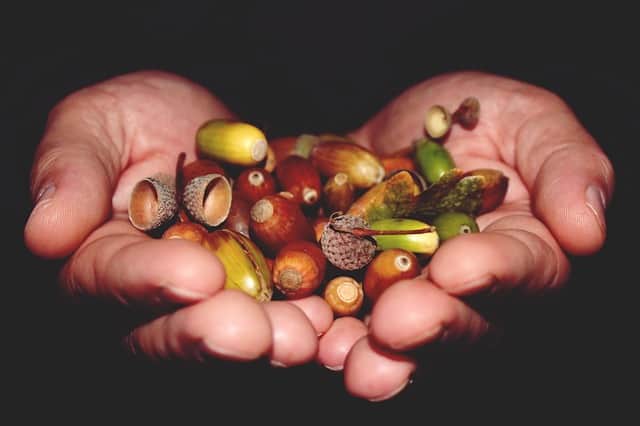
Eating acorns directly from the tree is generally considered a bad idea for humans; they can negatively affect digestion, cause constipation, and irritate the stomach lining (not good in a survival situation).
Recommended Reading: Homemade Natural Remedies For Diarrhea
This is because acorns contain tannins (natural chemicals which protect the tree). The good news is that tannins can easily be removed by soaking them in water.
There are several different methods you can use to make your acorns edible.
*Note: You must test your acorns throughout the leaching process. If they are still bitter, they still contain tannins. This small amount of tannins doesn’t cause you any harm, so don’t worry about being poisoned.
The Primitive Leaching Method:
Archaeologists have uncovered primitive methods that were used to make acorns edible. A shallow pit was dug near a water source like a stream. The pit was lined with sand, and the ground-up acorns were put into it (or a basket was put into the pit). A layer of pine needles or sand was placed on top of the acorn meal.
Water from the ground and rain would flow through the acorn meal, washing away the tannins. It would take days or weeks for the leaching to be complete, but it required virtually no effort. (9)
Cold Water Leaching Method:
This method takes many days. However, it retains more of the acorn taste (and probably preserves more nutrients, too, but I don’t have any scientific data to back that statement up).
- Fill a jar halfway up with acorn meal.
- Cover with cold water.
- Put a lid on the jar and shake up the acorn and water mixture.
- Keep the jar in the fridge.
- Every 24 hours, strain off the water, replace with fresh water, and shake again.
- The acorns are ready to eat when they don’t taste bitter anymore. (10)
Hot Water Leaching Method:
This method is much faster to get the tannins out of acorns, but it requires more hands-on work. There is also less room for error, so I prefer the cold-water method.
You must use bigger pieces of acorn meal for the hot water method to work. If your acorns have been ground into a fine meal, you’ll end up with a mush that can’t be strained.
- Boil two big pots of water.
- Put your acorns into a drawstring cloth bag. Put this bag into one of the pots of boiling water.
- When the water turns dark (after about 10 minutes), pour off the boiling water.
- Put the bagged acorns into the second pot of clean, boiling water.
- Refill the first pot and start it boiling again.
- Continue to dump off the dark water and move the acorns from pot to pot.
- The acorns are done once the water is clear-ish, and they don’t taste bitter.
Step 7: Drying Your Acorn Meal
Now that you’ve leached the tannins from the acorns strain the acorn meal through a cheesecloth (an old lace curtain or even pantyhose works well too).
Squeeze to get rid of any excess liquid.
Now, spread the acorns out on a tray. You can let them air dry, but it is best to dry them at low heat in the oven.
Step 8: Making Acorn Flour
Once your acorns are dried, they can be ground into flour or meal. You’ll need a high-powered blender or tough hand mill to do this.
How Long Will Acorn Flour Last?
Acorns have a lot of natural oils in them. If left out of the fridge, acorn flour probably won’t last more than a few weeks.
To keep your acorn flour fresh, keep it in the freezer. It will last (at least) two years this way.
Acorn Recipe Ideas
You can eat acorns just like you’d eat any nuts (part of trail mix, put on salads, as a snack…). Here are some more creative ideas using acorn meal and acorn flour.
Have you tried eating acorns? How did it go, and what did you make with them? Let us know in the comments!
Larva de Balanino o Gorgojo de las bello” (CC BY-SA 2.0) by jacilluch“The Oak Nut” (CC BY-NC 2.0) by TERRY KEARNEY“
2011-09-28 – Foraged Acorns – 0030 flickr photo by smiteme shared under a Creative Commons (BY-NC-ND) license
Autumn_Swamp_White_Oak_Leaf by Ninjatacoshell, Creative Commons Attribution-Share Alike 3.0 Unported license.


I’d eat them off the ground as a kid. They’d be nice and ripe and I’d always check for bugs first.
I have a 5 gallon bucket of them now. Green and still on twigs, that were on a tree a storm took down. I’ll let them ripen up and then soak the tannins out and try roasting.
I never knew you could eat acorns. I always wanted to try one. We had a Chestnut tree at my childhood home. My Dad would roast them on top of our wood stove in the basement. They were absolutely delicious! We first had to cut an X on top of the chestnut then soak them in cold water. Mom would strain them and take them downstairs for Dad to roast. When the shell started opening up, you knew they were done. They burn very easily, so you have to keep an eye on them. Delicious
Gambel oaks in the SW USA are so low in tannins they can be eaten raw without processing. Taste like macadamia nuts!
great information i tried to give away Acorns form my 2 red oak trees no takers… sad but the squirrels got a lot of them.
keebler.
I’ve heard that oak trees haven’t been domesticated for an agricultural nut crop because they’re wind-pollinated. I wonder if gene editing could be used to develop a tannin-free acorn?
I wouldn’t be surprised if it were possible. Unfortunately, even if it was possible, I doubt it would happen anytime soon considering that the vast majority of farmland/cultivated land is only used for a handful of crops. Too bad for us who want to eat something other than corn, wheat and soy. :/
Hello! I’m new here.
Here I’m Spain there are oaks which produces “sweet” acorns. I mean, acorns that you can eat raw with only a bit of bitterness, or sweet like chestnut once cooked on the coals. Only cooking (without putting in water) can release the tannins? Thanks for all your advices!
Best flavorful and easiest to process type of acorn to use for processing for food, red oak, white oak, Post oak, Bur oak, Pin oak, etc.?
Can you eat the acorns after step 6 or 7 or do you have to bake them?
one quick question I’ve seen those larvae can you eat them raw?
Always preferable to cook them to kill any parasites – read more about eating insects.
I here that there suppose to tast like popcorn
I wouldn’t say it tastes like popcorn. It’s too earthy of a taste. Almost like potato skins.
You state that White Oaks have a higher tannin level than Reds. This is the exact opposite in my experience for my area. The white oak acorns in my area are so mild, they can actually be dried, shelled and eaten without leaching. The reds, not so much due to the bitter tannin levels. Around here the deer won’t touch red oak acorns, but I have to fight them for the white oak acorns.
I guess the Tannin levels can be affected by many different variables. Just shows why local knowledge can be so important.
Are you by chance in the southwest USA? Gambel’s oaks here – the acorns can be eaten right from the trees.
Can you steam the acorns to release the tannins and cook the nut in a survival situation?
Hi Ma-T . Pretty sure steaming would not work in this scenario, but if anyone knows any different please leave a comment.
Is it safe for a dog to eat acorns
No it is not safe for dogs to eat acorns, the tannins can cause sickness and diarrhea. Acorns can also cause abdominal obstructions and blockages.
Can dogs eat acorns that have been processed as above for human consumption? Dog-specific food might be hard to come by in a survival situation, and meat could be very dear.
I don’t know the definitive answer to this but would assume that if the tannin’s are leached as per the instructions here then they would be OK. Speak to a vet if unsure.
The easiest way to deal with shelled accords is to either secure them in a stuff/net/cotton sack (a jelly bag works great) in a clear cool moving stream, or in your toilet tank. Screw all this shaking and straining and boiling and such. Just wait a while. Since they’re a fall crop you should still have plenty of food left by the time they’re done leaching the tannins out. You also don’t need a high powered blender or hand mill to make them into flour a microplane grater works fine, if slowly, or you can use a coffee mill for quicker processing.
Some good alternative ideas there. Whatever gets the job done is good.